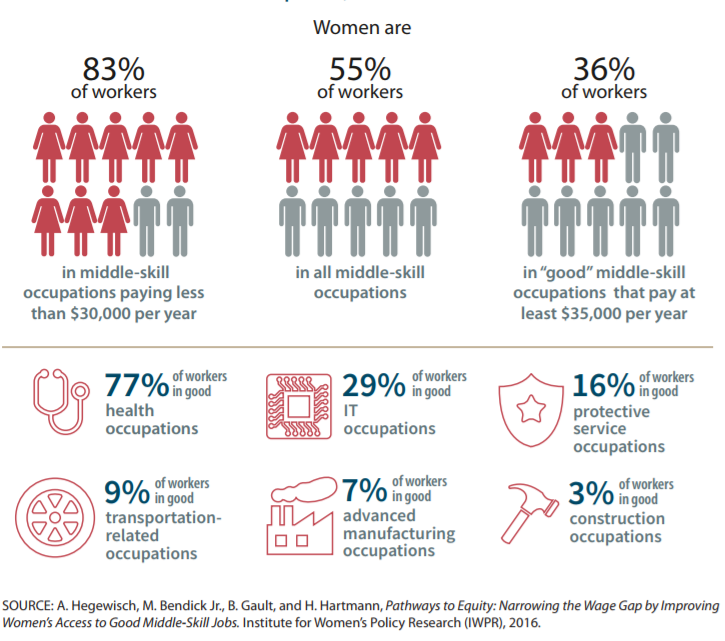This blog series examines trends in state uses of federal stimulus funding for Career Technical Education (CTE). Stimulus funds were appropriated for emergency relief related to the coronavirus pandemic through the federal Coronavirus Aid, Relief and Economic Security (CARES) Act; the Coronavirus Response and Relief Supplemental Appropriations Act (CRRSAA); and the American Rescue Plan (ARP) Act. The five major stimulus funding streams for states and educational institutions include the Coronavirus Relief Fund (CRF), the Elementary and Secondary School Emergency Relief (ESSER) Fund, the Governor’s Emergency Education Relief (GEER) Fund, the Higher Education Emergency Relief Fund (HEERF), and Coronavirus State and Local Fiscal Recovery Funds.
![]() During a time of mass economic disruption caused by the coronavirus pandemic, preparing displaced workers and learners for high-quality, long-term job opportunities is essential to close the skills gap and address shifting labor market demands. Job and income losses resulting from the pandemic have disproportionately impacted women, Black and Latinx workers, and low-wage and non-college educated workers. These populations will be key to target with federal coronavirus relief funds.
During a time of mass economic disruption caused by the coronavirus pandemic, preparing displaced workers and learners for high-quality, long-term job opportunities is essential to close the skills gap and address shifting labor market demands. Job and income losses resulting from the pandemic have disproportionately impacted women, Black and Latinx workers, and low-wage and non-college educated workers. These populations will be key to target with federal coronavirus relief funds.
Some states are already investing federal funds in establishing and expanding credential and training programs to address critical skills shortages and build a highly-skilled, resilient workforce for the future. South Dakota invested $2.2 million in GEER funding to launch UpSkill, a program to support workers displaced by the pandemic through 24 fully- or partially-funded certificate programs within the state’s four technical colleges. There is a clear pathway for participants to earn an Associate of Applied Science or bachelor’s degree, and the programs are offered in virtual, in-person or hybrid modalities and aligned with labor market demand.
Similarly, Delaware leveraged $10 million of the state’s CRF allocation to create the Rapid Workforce Training and Redeployment Initiative, which creates a process for establishing fully-funded training and certification programs for individuals who are unemployed or underemployed. These programs, developed by the Delaware Workforce Development Board in consultation with the state Department of Labor, will provide necessary skills for in-demand occupations and connect learners to employers and open opportunities in the state labor market.
Finally, Texas created new and innovative credential programs. The state used GEER to fund $25 million in Texas Reskilling and Upskilling for Education (TRUE) Institutional Capacity Grants for community, state and technical colleges to support efforts to create, expand or redesign high-value postsecondary workforce credential programs. Proposed programs must be under six months long, aligned to industry needs, and developed alongside key stakeholders to qualify for these competitively-awarded grants. Texas also focused on re-engaging learners through a $46.5 million GEER allocation toward financial aid for individuals enrolled in programs centered on up-skilling or re-skilling displaced workers for in-demand fields. The initiative targets learners who have earned some college credit to ensure that they remain on track to attain a postsecondary credential.
These state efforts will ensure that displaced workers and learners who have been disproportionately impacted by the pandemic can connect with meaningful CTE opportunities and career pathways. What is notable about these initiatives is that they not only connect displaced workers with job opportunities, addressing immediate unemployment concerns, but help workers access better opportunities that are in demand and offer high wages. By strategically investing federal relief funds to build and scale short-term training programs that are driven by labor market demand, states can leverage the current crisis to build a stronger workforce and more economic opportunity for the future. Coronavirus relief funds continue to provide a valuable means of investment in establishing and expanding high-quality CTE programs for long-term learner success in a continually shifting labor market.
To learn more about how states have spent federal relief funds on CTE, please stay tuned for future Coronavirus Relief Funds blog posts and visit Advance CTE’s coronavirus resource page for additional resources.
Allie Pearce, Graduate Fellow


